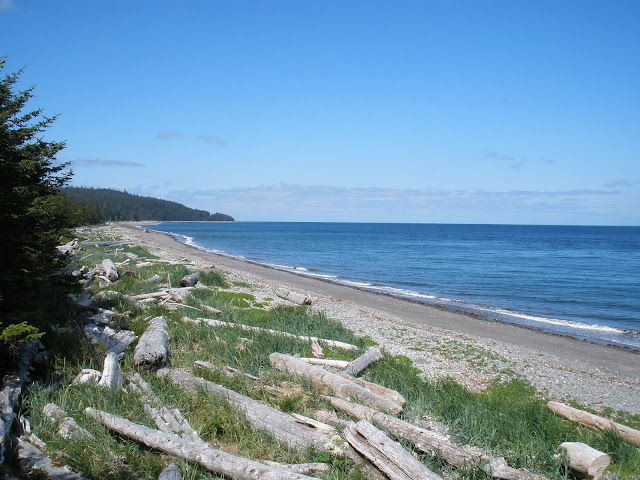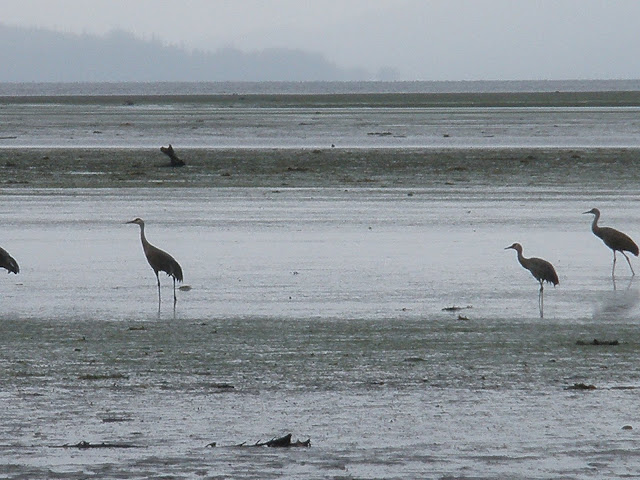New globe presented to all schools in British Columbia with the name change.
Before explorers, most places had names, often very practical names like "island of the people" however when people took to the seas and found new places they named them in honour of their motherland, ship or wife! And so it was with Xaadaa Gwaayaay (Haida Gwaii).
The islands were first visited by Juan Perez in 1774 and Captain James Cook in 1778. In 1887 the Islands were surveyed by Captain George Dixon and he named them after one of his ships, the "Queen Charlotte" which was named for Queen Charlotte, wife of King George III of the United Kingdom.
Through the Council of the Haida Nation, the Haida have lobbied to have the Islands returned to their rightful name and on June 3, 2010 Bill 18, the
Haida Gwaii Reconcilliation Act was passed by the British Columbia Legislature and signed into law.
Premier Gordon Campbell with the bentwood box containing the name "Queen Charlotte Islands".
The Haida have never used the name Queen Charlotte Islands and in a ceremony on June 17th they respectfully returned the name to the Queen's representative in British Columbia, Premier Gordon Campbell.
Button blanket
For the Haida who have never lived anywhere but here and who never signed a treaty with the "white man" this was a time of great celebration.
Nearly a 1000 Islanders shared in the celebration with singing and dancing
feasting and speeches and

Totems carved by Jordon Seward and Cooper Wilson at entrance to Old Masset
On June 21, National Aboriginal Day in Canada the Haida celebrated by raising six 10 foot totem poles in a day called A Splash of Art.
Watchmen totems carved by Todd White and Derek White
These two were carved for the Entrance into the Greater Massett area.
Detail on the poles is quite amazing.
Carver Vern White
Pole at the Family Centre in Old Masset.
The poles are carved from Western Red Cedar and are not treated with anything, they will eventually turn the colour of the building.
The "Jasper Totem" February 28, 2009 on my trip east.
The last act of this busy week was the repatriation of what is known as the Jasper Pole. For 94 years the magnificant Raven totem pole stood proudly in the Town of Jasper, Alberta. The Raven Totem was carved sometime during the 1870s-1880s in Masset on Haida Gwaii. The pole was originally 18-21 meters(60-70 ft,) in height however during the course of two moves within the town of Jasper, the pole was cut to its current height of 12 meters(40 ft.)
Masset circa 1890-Raven pole seventh from right Courtesy BC Archives
The original pole was plain cedar with no paint on its surface. During its lifetime in Jasper, the pole was painted several times to make it more "attractive" to park visitors!
The pole the day before it was cut down for the final time April 2009.
On the Pacific Northwest coast, most totem poles last 60 to 80 years. Once a pole has fallen, it is left to return to the earth. Wind, weather, fungi, insects and plant life all contribute to the decay of the old pole. The Jasper Raven Totem stood tall for over 130 years due to the drier climate of the Rocky Mountains, as well as the conservation efforts that have been made over its lifespan.
The Raven Totem Pole at home in Old Masset, June 21, 2010
After being cut down in April 2009 the Raven Pole travelled to Vancouver, BC to have lead paint removed, restoring it as best as possible to its natural state. It will never be raised again. It returned home to Masset where it will be housed in a new Long House.
Food was burned to pay tribute to the Ancestors while the Great grandson of the original carver looked on.
Click on any photo for more detail.
To visit other great places from around the world why not join us at


















































